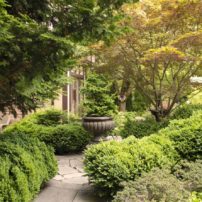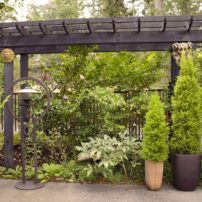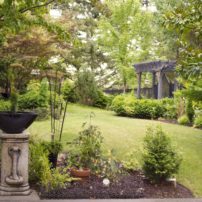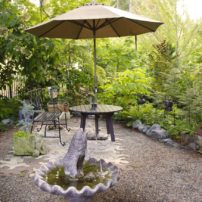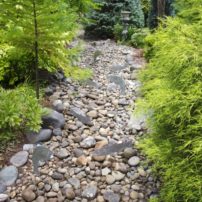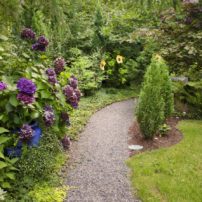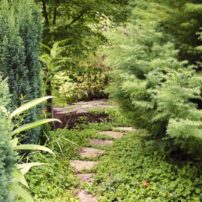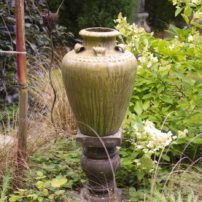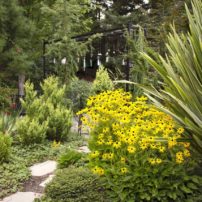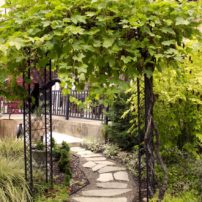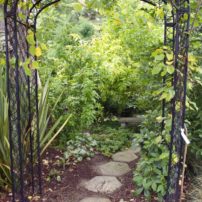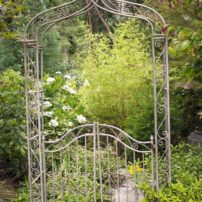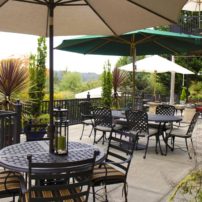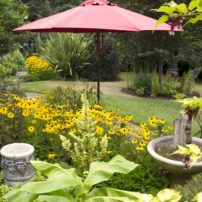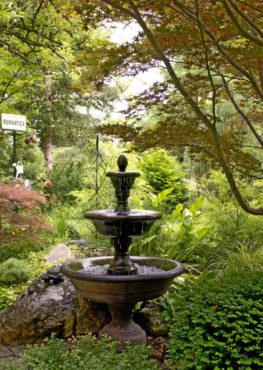 Some homes nestle quietly into their surroundings and appear as if they have been there for centuries. Tudor-style architecture is neither particularly rare nor common in the Northwest, and occasionally one stumbles upon a home that simply speaks to the heart.
Some homes nestle quietly into their surroundings and appear as if they have been there for centuries. Tudor-style architecture is neither particularly rare nor common in the Northwest, and occasionally one stumbles upon a home that simply speaks to the heart.
Such is the case with the stone-fronted, half-timber-style Fox Island home owned by Jerome and Lucinda Capers.

In 2004, with retirement looming on their horizon, the couple began thinking how nice it would be to leave a congested metropolitan area where Jerome Capers suffered a long daily commute. The idea of leaving the Bay Area was enticing, but where to settle next was the real challenge. Avid travelers, the Caperses have visited nearly every corner of the United States, enjoying and appreciating some areas more than others, and so they began to work on a short list.
As they traveled from Maine to New Mexico, dozens of potential communities were scratched off their list. Some places were too expensive; some had a season or two that made them undesirable. Some didn’t fit the “feel” they were looking for in a community, were too crowded or were not populated enough.
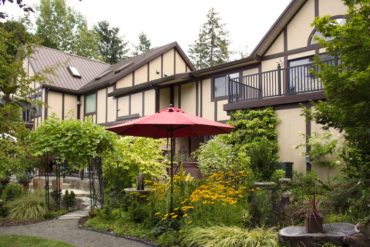 Coincidentally Lucinda Capers, who had worked for an international transportation company, received a call from a recruiter with a job offer in Washington. Although the couple had visited Washington frequently, they had not given much thought about moving to the Northwest. They loved Washington in general but most of the areas they explored seemed too populated.
Coincidentally Lucinda Capers, who had worked for an international transportation company, received a call from a recruiter with a job offer in Washington. Although the couple had visited Washington frequently, they had not given much thought about moving to the Northwest. They loved Washington in general but most of the areas they explored seemed too populated.
A free day to explore farther afield brought them to Gig Harbor, and suddenly everything started to fall into place. Through a serendipitous series of events, the home on Fox Island was secured, and Lucinda and Jerome Capers knew they were home at last.
The Fox Island property had everything they were looking for: a sturdily built home that was relatively modern; a large property that would afford them lots of gardening space; a beautiful, far-reaching view; a location not too far from goods and services; and lots of peace and quiet.
 Purchased from the original designer-builder, the home was about 20 years old, sitting on a 2-acre-plus property that was originally split down the middle, as half of it was used as horse pasture. The Caperses are not horse people but they saw potential in the large property for their own landscape design. The house itself has many custom touches and built-in conveniences such as wiring for an auxiliary generator, a fresh-air-exchange system and theater lighting in the stairwell.
Purchased from the original designer-builder, the home was about 20 years old, sitting on a 2-acre-plus property that was originally split down the middle, as half of it was used as horse pasture. The Caperses are not horse people but they saw potential in the large property for their own landscape design. The house itself has many custom touches and built-in conveniences such as wiring for an auxiliary generator, a fresh-air-exchange system and theater lighting in the stairwell.
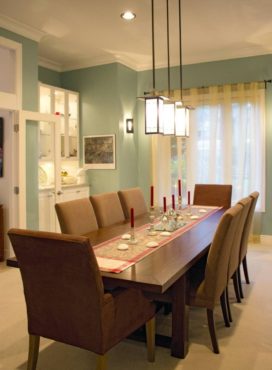 Over the years, the couple have replaced the lighting throughout the home and remodeled the kitchen, powder room and laundry. “Rather than make any major changes, we work with what is here to better suit our needs,” Lucinda Capers said.
Over the years, the couple have replaced the lighting throughout the home and remodeled the kitchen, powder room and laundry. “Rather than make any major changes, we work with what is here to better suit our needs,” Lucinda Capers said.
The entrance welcomes one into a large foyer. Although the home style may be basically Tudor, the interior has a warm and very sophisticated Mediterranean feel. It is readily apparent these residents are widely travelled and have carried bits and pieces of their many experiences with them to this home.
The main living area is light and airy, with massive windows facing the extensive grounds and overlooking the view to the Sound. The classic decor gives the feeling of substance and continuity, while being fresh and modern at the same time.
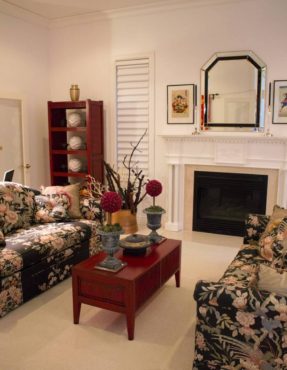 Gardening has been a lifetime passion for the couple. Both were influenced by their grandparents’ love of gardening, and each of them carries happy memories of their experiences as youngsters.
Gardening has been a lifetime passion for the couple. Both were influenced by their grandparents’ love of gardening, and each of them carries happy memories of their experiences as youngsters.
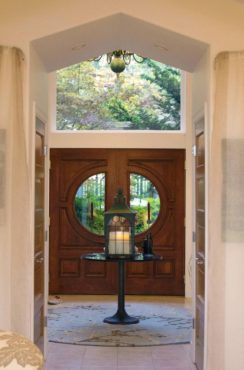 As a child, Lucinda asked for a yew for her birthday one year, but it was her discovery that she could plant a willow twig and have it turn into a tree that really ignited her passion for gardening. Jerome Capers tells a story about his wife always needing something growing around her. At one point in his career, they lived in El Centro, California, in a house with a large, west-facing window in which the sun blasted heat every afternoon. Lucinda Capers asked her husband to fasten strings from the ground to the roof eaves, and then she planted morning glories, which quickly grew to shade the sun as well as give them something lovely to look at.
As a child, Lucinda asked for a yew for her birthday one year, but it was her discovery that she could plant a willow twig and have it turn into a tree that really ignited her passion for gardening. Jerome Capers tells a story about his wife always needing something growing around her. At one point in his career, they lived in El Centro, California, in a house with a large, west-facing window in which the sun blasted heat every afternoon. Lucinda Capers asked her husband to fasten strings from the ground to the roof eaves, and then she planted morning glories, which quickly grew to shade the sun as well as give them something lovely to look at.
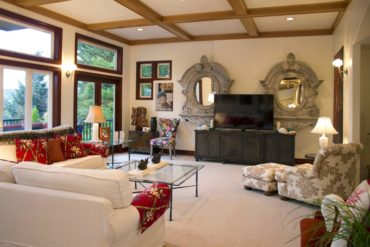 An assessment of the Fox Island property soon led to making an imaginative design plan and to first steps in making the property their own. The dividing fence came down; the area was cleared of blackberries and Lucinda Capers began to move existing plants, grouping them according to her vision. Erin Rockery was contracted to excavate and install a dry-creek bed.
An assessment of the Fox Island property soon led to making an imaginative design plan and to first steps in making the property their own. The dividing fence came down; the area was cleared of blackberries and Lucinda Capers began to move existing plants, grouping them according to her vision. Erin Rockery was contracted to excavate and install a dry-creek bed.
The upper quadrant of the property was left natural as a backdrop to the more formal design of the main garden. The horse barn was transformed by taking out the stalls and adding wiring, outlets and lighting. Eventually it will be set up as a workshop and garden potting area.
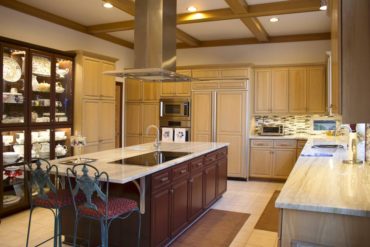 Every garden should serve the needs of the inhabitants of the home, so this one needed to have plenty of focal areas of interest, places to sit, rest and view the garden from several different vantage points. There needed to be year-round interest, a good mix of foliage plants and flowering ones, as well as evergreen bones and good deciduous structure. It needed a place to entertain as well as six strategically placed water features and birdbaths.
Every garden should serve the needs of the inhabitants of the home, so this one needed to have plenty of focal areas of interest, places to sit, rest and view the garden from several different vantage points. There needed to be year-round interest, a good mix of foliage plants and flowering ones, as well as evergreen bones and good deciduous structure. It needed a place to entertain as well as six strategically placed water features and birdbaths.
Although there were several landscape plants already established, few of them worked in Lucinda’s design. Dozens of rose bushes originally scattered around the property were gathered up — some salvaged, but most of them either given away or scrapped in favor of more desirable plants. As deer roam freely over the property, it was necessary to think of landscape plants that they generally avoid.
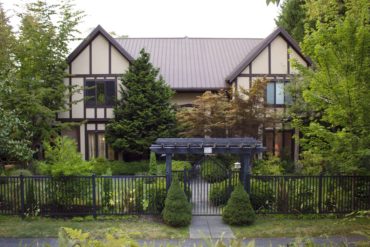 Lucinda has learned that deer mostly ignore daffodils, peonies, hellebores and oriental lilies. Day lilies and tulips are like deer candy, so those are never planted in the Capers’ garden. Other desirable plants that deer ignore but that do well in Northwest gardens are the Mediterranean aromatic herbs such as members of the artemisia family, lavenders and salvias.
Lucinda has learned that deer mostly ignore daffodils, peonies, hellebores and oriental lilies. Day lilies and tulips are like deer candy, so those are never planted in the Capers’ garden. Other desirable plants that deer ignore but that do well in Northwest gardens are the Mediterranean aromatic herbs such as members of the artemisia family, lavenders and salvias.
All plants that produce interesting seed heads are left for winter interest and for the birds that feed on winter seeds. Another consideration in addition to pest resistance and year-round interest is how much care and maintenance a plant requires. Roses are fussy about pruning and tend to be heavy feeders, for instance.
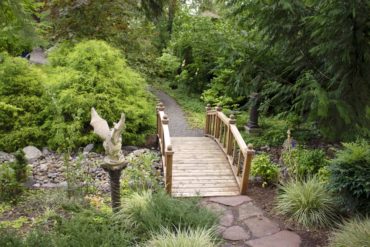 Lucinda Capers has discovered a little-known member of the hydrangea family, H. serrata. Hailing from the mountains of Korea, this plant has a beautiful natural shape and structure and is also self-pruning. The flowers, which are pale lilac naturally, grow on old wood and the foliage turns a magnificent yellow in the fall. Cultivars of this plant are beginning to appear in specialty nurseries in deeper shades of pinks and blues, and like other members of the hydrangea family, the color may be adjusted by changing the soil pH.
Lucinda Capers has discovered a little-known member of the hydrangea family, H. serrata. Hailing from the mountains of Korea, this plant has a beautiful natural shape and structure and is also self-pruning. The flowers, which are pale lilac naturally, grow on old wood and the foliage turns a magnificent yellow in the fall. Cultivars of this plant are beginning to appear in specialty nurseries in deeper shades of pinks and blues, and like other members of the hydrangea family, the color may be adjusted by changing the soil pH.
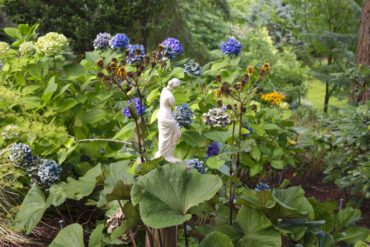 Although perennial plants offer seasonal color, they do add to the workload by requiring deadheading and dividing from time to time. So at this point, she is concentrating on improving the “bones” of the garden by putting in more interesting shrubs such as H. serrata and spending less time on the more labor-intensive perennials. Trees that offer year-round interest, such as Japanese maples, Parrotia persica and stewartia, are also favorites of this gardening duo.
Although perennial plants offer seasonal color, they do add to the workload by requiring deadheading and dividing from time to time. So at this point, she is concentrating on improving the “bones” of the garden by putting in more interesting shrubs such as H. serrata and spending less time on the more labor-intensive perennials. Trees that offer year-round interest, such as Japanese maples, Parrotia persica and stewartia, are also favorites of this gardening duo.
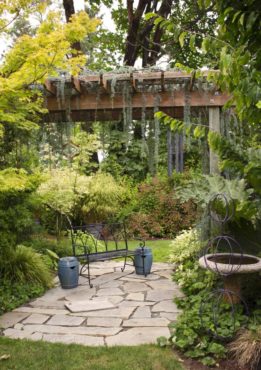 Recently, a built-up bed that flanks the steps from the veranda to the lower level has been planted with miniature members of the Japanese cypress and Japanese cedar families. Slow-growing, sporting interesting foliage and shapes, the plants in this new specimen garden will bring years of pleasure in watching them grow and develop.
Recently, a built-up bed that flanks the steps from the veranda to the lower level has been planted with miniature members of the Japanese cypress and Japanese cedar families. Slow-growing, sporting interesting foliage and shapes, the plants in this new specimen garden will bring years of pleasure in watching them grow and develop.
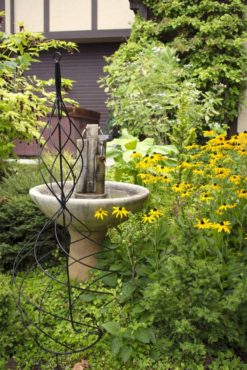 About three-fourths of the entire property area is cultivated with flower beds, lawns and ornamental shrubbery. An in-ground irrigation system, which features multiple zones for controlling the amount of water each area receives, saves time and energy in watering but also affords a more efficient use of water. With the exception of a lawn service employed to mow regularly during the growing season, the couple do all of their own gardening.
About three-fourths of the entire property area is cultivated with flower beds, lawns and ornamental shrubbery. An in-ground irrigation system, which features multiple zones for controlling the amount of water each area receives, saves time and energy in watering but also affords a more efficient use of water. With the exception of a lawn service employed to mow regularly during the growing season, the couple do all of their own gardening.
They have a regular maintenance schedule that changes seasonally and they maintain a gardening calendar to keep track of what needs to be done each month.
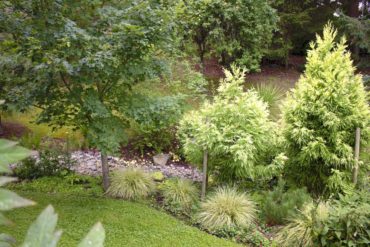 “Jerome is the best hole digger on Fox Island,” Lucinda said.
“Jerome is the best hole digger on Fox Island,” Lucinda said.
In the winter, when the garden sleeps, deciduous shrubs are inspected for shape and size, and pruning takes place while the plants are dormant. Springtime is when plants are moved to a new spot in the garden if they are starting to grow too large for their space. Summer is spent continually maintaining and weeding to just keep it all under control, and the cooler fall temperatures afford the opportunity to divide perennials for increasing their numbers or sharing with friends.
They spend an average of about two to three hours per day gardening year-round. When they aren’t at home gardening, they are traveling, with visiting gardens in other places always the focus of their trip.
Lucinda and Jerome Capers have been married 56 years. They love being “here — in this place.”
“We have serenity now,” Jeromy said. Lucinda added, “We eat breakfast, lunch and dinner together and we garden together. It doesn’t get much better than this.”




